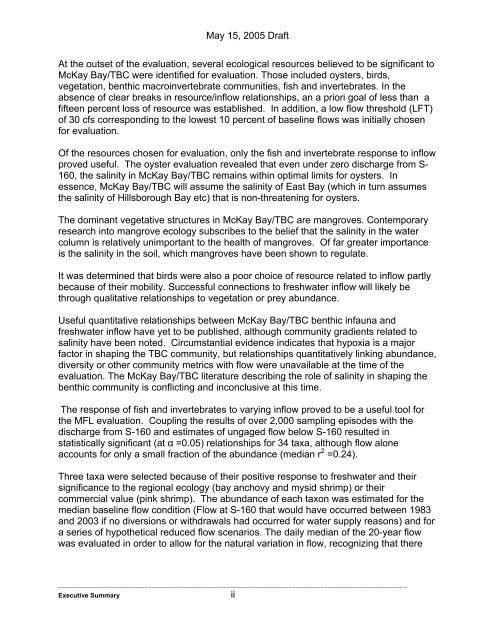Minimum Flows for the Tampa Bypass Canal, Tampa - Southwest ...
Minimum Flows for the Tampa Bypass Canal, Tampa - Southwest ...
Minimum Flows for the Tampa Bypass Canal, Tampa - Southwest ...
Create successful ePaper yourself
Turn your PDF publications into a flip-book with our unique Google optimized e-Paper software.
May 15, 2005 Draft<br />
At <strong>the</strong> outset of <strong>the</strong> evaluation, several ecological resources believed to be significant to<br />
McKay Bay/TBC were identified <strong>for</strong> evaluation. Those included oysters, birds,<br />
vegetation, benthic macroinvertebrate communities, fish and invertebrates. In <strong>the</strong><br />
absence of clear breaks in resource/inflow relationships, an a priori goal of less than a<br />
fifteen percent loss of resource was established. In addition, a low flow threshold (LFT)<br />
of 30 cfs corresponding to <strong>the</strong> lowest 10 percent of baseline flows was initially chosen<br />
<strong>for</strong> evaluation.<br />
Of <strong>the</strong> resources chosen <strong>for</strong> evaluation, only <strong>the</strong> fish and invertebrate response to inflow<br />
proved useful. The oyster evaluation revealed that even under zero discharge from S-<br />
160, <strong>the</strong> salinity in McKay Bay/TBC remains within optimal limits <strong>for</strong> oysters. In<br />
essence, McKay Bay/TBC will assume <strong>the</strong> salinity of East Bay (which in turn assumes<br />
<strong>the</strong> salinity of Hillsborough Bay etc) that is non-threatening <strong>for</strong> oysters.<br />
The dominant vegetative structures in McKay Bay/TBC are mangroves. Contemporary<br />
research into mangrove ecology subscribes to <strong>the</strong> belief that <strong>the</strong> salinity in <strong>the</strong> water<br />
column is relatively unimportant to <strong>the</strong> health of mangroves. Of far greater importance<br />
is <strong>the</strong> salinity in <strong>the</strong> soil, which mangroves have been shown to regulate.<br />
It was determined that birds were also a poor choice of resource related to inflow partly<br />
because of <strong>the</strong>ir mobility. Successful connections to freshwater inflow will likely be<br />
through qualitative relationships to vegetation or prey abundance.<br />
Useful quantitative relationships between McKay Bay/TBC benthic infauna and<br />
freshwater inflow have yet to be published, although community gradients related to<br />
salinity have been noted. Circumstantial evidence indicates that hypoxia is a major<br />
factor in shaping <strong>the</strong> TBC community, but relationships quantitatively linking abundance,<br />
diversity or o<strong>the</strong>r community metrics with flow were unavailable at <strong>the</strong> time of <strong>the</strong><br />
evaluation. The McKay Bay/TBC literature describing <strong>the</strong> role of salinity in shaping <strong>the</strong><br />
benthic community is conflicting and inconclusive at this time.<br />
The response of fish and invertebrates to varying inflow proved to be a useful tool <strong>for</strong><br />
<strong>the</strong> MFL evaluation. Coupling <strong>the</strong> results of over 2,000 sampling episodes with <strong>the</strong><br />
discharge from S-160 and estimates of ungaged flow below S-160 resulted in<br />
statistically significant (at α =0.05) relationships <strong>for</strong> 34 taxa, although flow alone<br />
accounts <strong>for</strong> only a small fraction of <strong>the</strong> abundance (median r 2 =0.24).<br />
Three taxa were selected because of <strong>the</strong>ir positive response to freshwater and <strong>the</strong>ir<br />
significance to <strong>the</strong> regional ecology (bay anchovy and mysid shrimp) or <strong>the</strong>ir<br />
commercial value (pink shrimp). The abundance of each taxon was estimated <strong>for</strong> <strong>the</strong><br />
median baseline flow condition (Flow at S-160 that would have occurred between 1983<br />
and 2003 if no diversions or withdrawals had occurred <strong>for</strong> water supply reasons) and <strong>for</strong><br />
a series of hypo<strong>the</strong>tical reduced flow scenarios. The daily median of <strong>the</strong> 20-year flow<br />
was evaluated in order to allow <strong>for</strong> <strong>the</strong> natural variation in flow, recognizing that <strong>the</strong>re<br />
_________________________________________________________________________________________________<br />
Executive Summary<br />
ii

















